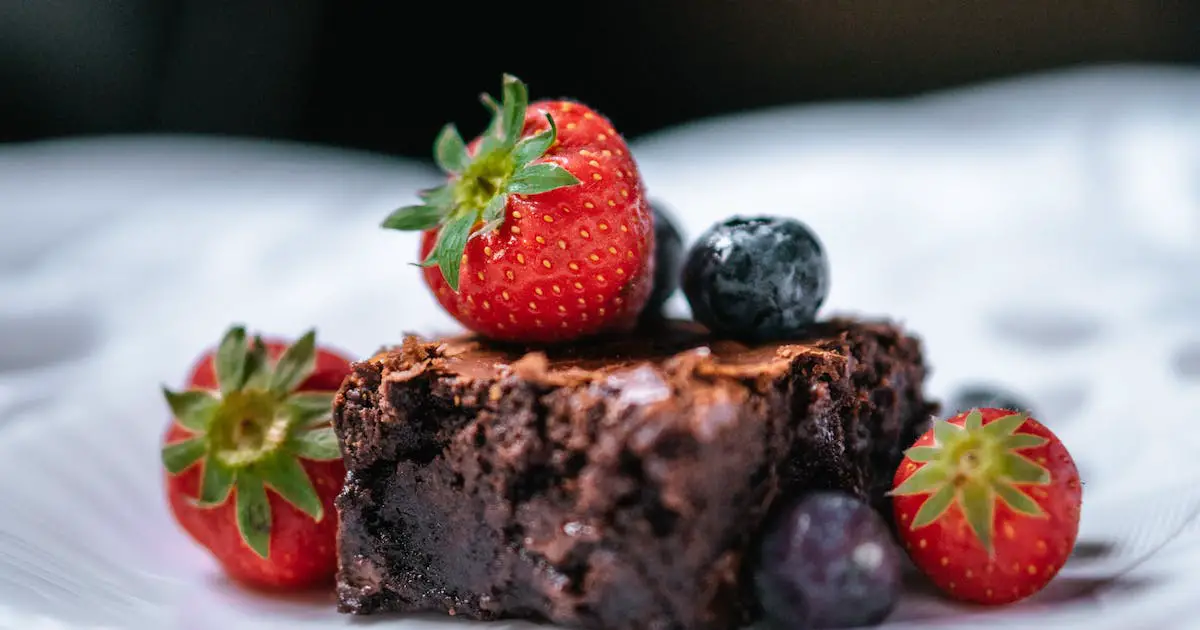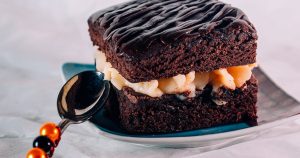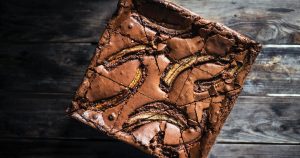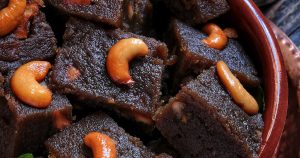The Science of Fudgy vs. Cakey Brownies Textures
The texture of a brownie, whether fudgy or cakey, is a result of a fascinating interplay of ingredients, proportions, and baking techniques. Understanding this science is key to mastering the art of brownie-making. Let’s dive into the factors that influence the texture of brownies:
-
Role of Ingredients in Fudgy vs. Cakey Brownies:
- Fat: The amount and type of fat, be it butter or oil, play a significant role. More fat contributes to a denser, fudgy texture, while less fat leads to a lighter, cakey texture.
- Sugar: Sugar not only sweetens but also affects moisture and texture. It helps create a tender crumb by absorbing liquid and softening the flour’s protein structure.
- Flour: The quantity of flour impacts the texture significantly. Less flour results in a fudgier brownie, as it limits the formation of gluten, which is responsible for creating structure.
-
Chemical Reactions in Baking:
- Leavening Agents: The presence and type of leavening agents, like baking powder or baking soda, can influence the texture. Baking powder produces a lighter, cake-like texture, while its absence or minimal use leads to denser brownies.
- Egg Ratio: Eggs contribute to structure and richness. More eggs will result in a cakey texture due to the added protein and moisture they provide.
-
Moisture Content for Fudgy vs. Cakey Brownies:
- Liquid Ingredients: The amount of liquid (water, milk, or other liquids) in the batter affects the moisture level, which in turn influences the brownie’s texture. More liquid can make the brownie more cake-like.
-
Mixing Technique:
- Gluten Development: The method and duration of mixing the batter affect gluten development. Overmixing can lead to a tougher, more cake-like texture due to more gluten formation.
-
Baking temperature and time:
- Oven Heat: The temperature at which brownies are baked can alter their texture. A higher temperature can set the edges quickly, creating a fudgy center with a crusty edge.
- Baking Duration: The length of the baking time also plays a crucial role. Shorter baking times result in a moister, fudgier texture, while longer baking times produce a drier, cakey texture.
By understanding these scientific principles, you can manipulate the ingredients and baking process to achieve your desired brownie texture. Whether it’s adjusting the flour-to-fat ratio for fudginess or tweaking the baking time for a cakey rise, the science of brownie textures is a blend of chemistry and culinary art. For a deeper dive into the role of specific ingredients in baking, consider exploring What are the Ingredients in Brownie Mix?.
Ingredients for Fudgy Vegan Brownies
- Flour: 1 cup (all-purpose flour works best for a classic brownie texture)
- Cocoa Powder: 3/4 cup (unsweetened, for a rich chocolate flavor)
- Baking Powder: 1 teaspoon (to help the brownies rise)
- Salt: 1/4 teaspoon (to balance the sweetness)
- Sugar: 1 cup (you can use white, brown, or a mix of both)
- Oil: 1/2 cup (vegetable or coconut oil for moisture)
- Vanilla Extract: 1 teaspoon (for flavor enhancement)
- Water or Almond Milk: 1 cup (to mix the ingredients; almond milk adds a slight nutty flavor)
- Vegan Chocolate Chips: 1/2 cup (optional, for extra gooeyness)
- Nuts: 1/2 cup chopped walnuts or pecans (optional, for added texture)
Instructions
- Preheat Oven: Set your oven to 350°F (175°C) and grease a square baking pan.
- Dry Ingredients: In a large bowl, whisk together the flour, cocoa powder, baking powder, and salt.
- Wet Ingredients: In another bowl, mix the sugar, oil, vanilla extract, and water or almond milk.
- Combine: Pour the wet ingredients into the dry ingredients and mix until just combined. Don’t overmix.
- Add Extras: Fold in the chocolate chips and nuts if using.
- Bake: Pour the batter into the prepared pan and smooth the top with a spatula. Bake for 20–25 minutes, or until a toothpick inserted in the center comes out mostly clean.
- Cool: Let the brownies cool in the pan before cutting into squares.
Ingredients for Cakey Brownies
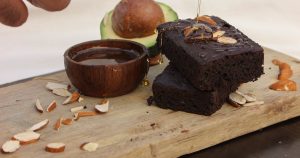
Flour:
The foundation of cakey brownies is a higher proportion of flour compared to fudgy brownies. This additional flour gives the brownies more structure and a lighter, airier texture. Typically, all-purpose flour is used for its balanced protein content, which is ideal for achieving the desired cake-like consistency.
Leavening Agents:
Cakey brownies often include leavening agents like baking powder or baking soda. These ingredients help the batter rise during baking, creating a fluffier and more cake-like texture. The amount and type of leavening agent can vary depending on the recipe, but their presence is a key differentiator from denser, fudgier brownies.
Eggs:
Eggs are crucial in cakey brownies for providing structure and stability. More eggs, particularly egg whites, are used in cakey brownie recipes compared to fudgy ones. The protein in the eggs helps to create a lighter texture, and the additional volume from the whites contributes to the rise and fluffiness of the brownies.
Sugar:
While sugar is a common ingredient in all brownies, the type and amount can influence the texture. Cakey brownies might use a combination of white and brown sugar, with a higher overall sugar content compared to fudgy brownies. This not only sweetens the brownies but also contributes to their lighter texture.
Butter or oil:
In cakey brownies, the amount of fat (butter or oil) is usually less than in fudgy brownies. This reduced fat content helps to achieve a less dense texture. Butter is often preferred for its flavor, but oil can also be used for a lighter crumb.
Milk or water:
Liquid ingredients like milk or water are added to the batter to adjust the consistency. In cakey brownies, the liquid helps to create a smoother batter that bakes into a lighter texture.
Vanilla Extract:
Vanilla extract is added for flavor enhancement. It complements the chocolate and adds depth to the overall taste of the brownies.
Cocoa Powder or Melted Chocolate:
The chocolate flavor in cakey brownies can come from cocoa powder, melted chocolate, or a combination of both. The choice depends on the desired intensity of the chocolate flavor and the recipe being used.
By carefully selecting and balancing these ingredients, you can create delicious, cakey brownies that are light, fluffy, and satisfyingly sweet. The key is to maintain the right proportions to ensure that the brownies have the characteristic cake-like texture that sets them apart from their fudgy counterparts. For unique flavor ideas, check out Earl Grey Cookies for inspiration.
Baking Techniques for Different Textures
Achieving the perfect brownie texture, whether fudgy or cakey, is an art that involves precise baking techniques. The way you mix the ingredients, prepare the baking pan, and control the oven settings can significantly impact the final outcome. Here are some key baking techniques tailored to create different brownie textures:
-
Mixing Methods:
- For fudgy brownies, mix the ingredients just enough to combine them. Overmixing can incorporate too much air and develop gluten, leading to a cakey texture. A gentle fold is often all that’s needed.
- For cakey brownies, whisk the batter more vigorously to incorporate air. This helps in achieving a lighter, fluffier texture akin to cakes.
-
Baking Temperatures and Times:
- Fudgy Brownies: Bake at a slightly lower temperature for a shorter period. This approach allows the center to remain moist and dense while the edges get slightly crispy.
- Cakey Brownies: Use a moderate-to-high oven temperature to create a quicker rise and a more evenly baked texture throughout.
-
Pan Selection and Preparation:
- Material: Metal pans are ideal for fudgy brownies as they heat up quickly, helping to create a moist center and crisp edges. Glass or ceramic pans are better for cakey brownies, as they heat more evenly.
- Preparation: Lining the pan with parchment paper and greasing it lightly can prevent sticking and make it easier to remove the brownies. For fudgy brownies, a light dusting of cocoa powder on the pan can add to the flavor and texture.
-
Ingredient Temperatures:
- Room-temperature ingredients blend more evenly, which is crucial for both fudgy and cakey brownies. Cold ingredients can lead to uneven mixing and affect the texture.
-
Checking for doneness:
- Use a toothpick or a cake tester to check for doneness. For fudgy brownies, it should come out with a few moist crumbs. For cakey brownies, it should come out mostly clean.
-
Cooling:
- Allow the brownies to cool in the pan for fudgy brownies as they continue to set and develop texture. For cakey brownies, cooling on a wire rack prevents them from becoming too moist.
-
Slicing Techniques for Fudgy vs. Cakey Brownies:
- Use a sharp knife for clean cuts. For fudgy brownies, dipping the knife in hot water between slices can help achieve neat, clean cuts through the dense texture.
By mastering these baking techniques, you can have greater control over the texture of your brownies, ensuring that every batch meets your desired preference, be it irresistibly fudgy or delightfully cakey. If you’re looking for a healthier version of brownies, consider using substitutes like applesauce or avocado for some of the fat, or explore gluten-free options like pumpkin Pumpkin Banana Loaf.
Storing and Preserving Fudgy vs. Cakey Brownies
Proper storage and preservation are crucial for maintaining the freshness and texture of brownies. Whether you prefer them fudgy or cakey, the way you store them can make a significant difference in their taste and quality over time. Here are some effective tips for storing and preserving brownies:
-
Cooling Before Storage:
- Allow the brownies to cool completely at room temperature before storing. This prevents condensation inside the container, which can make them soggy.
-
Room Temperature Storage:
- Place the brownies in an airtight container to keep them moist and fresh. They can typically last for up to 3–4 days at room temperature.
- If you live in a hot or humid climate, consider storing them in a cooler place to prevent them from becoming too soft or melting.
-
Refrigerating Fudgy vs. Cakey Brownies:
- For longer storage, brownies can be refrigerated. Wrap them individually in plastic wrap or store them in an airtight container. This can extend their freshness for about a week.
- Refrigeration is particularly helpful for brownies with frosting or fillings that might spoil at room temperature.
-
Freezing for Long-Term Storage:
- Brownies freeze exceptionally well. Wrap them tightly in plastic wrap and then in aluminum foil, or place them in a freezer-safe, airtight container.
- They can be stored in the freezer for up to 3 months. To thaw, leave them at room temperature for a few hours or overnight in the refrigerator.
-
Slicing Before Storing:
- Slice the brownies before storing them, as this makes it easier to enjoy a piece at a time without exposing the entire batch to air each time.
-
Avoiding Dry Edges:
- To prevent the edges from drying out, store brownies in a container with a piece of bread. The bread helps maintain moisture levels inside the container.
-
Reviving Stale Brownies:
- If brownies begin to dry out, you can briefly warm them in the microwave to restore some of their moisture and softness.
-
Labeling and dating:
- When freezing brownies, label the container with the date so you know how long they have been stored.
By following these storage and preservation tips, you can enjoy your delicious brownies for days or even months, ensuring they remain as fresh and delightful as the day they were baked.
FAQs about Fudgy vs. Cakey Brownies
- How do I know when my brownies are perfectly baked? The best way to check is by inserting a toothpick into the center. For fudgy brownies, it should come out with a few moist crumbs attached. For cakey brownies, the toothpick should come out mostly clean.
- Can I make brownies without eggs? Yes, you can use egg substitutes like applesauce, mashed bananas, or commercial egg replacers. These alternatives help in binding the ingredients together, similar to eggs.
- Why do my brownies get hard around the edges? Hard edges are often a result of overbaking. To prevent this, start checking for doneness a few minutes before the recipe’s stated baking time. Also, using the right size pan is crucial.
- Can I add extra chocolate chips to my brownie mix? Absolutely! Adding chocolate chips or chunks can enhance the chocolate flavor and add texture. Stir them into the batter just before baking.
- How can I make my brownies more fudgy? Increase the fat content by adding more butter or oil, and reduce the amount of flour. Also, consider baking them for a slightly shorter time.
- Is it possible to make brownies without refined sugar? Yes, you can use alternatives like coconut sugar, honey, maple syrup, or agave nectar. Adjust the quantity to achieve the desired sweetness.
- How do I store leftover brownies? Store them in an airtight container at room temperature for up to 3–4 days. For longer storage, you can refrigerate or freeze them.
- Can I make gluten-free brownies? Yes, substitute the regular flour with a gluten-free flour blend. Ensure that other ingredients, like baking powder, are also gluten-free.
Conclusion
In the delightful journey of baking brownies, understanding the nuances between fudgy and cakey brownie textures is an essential skill for any baker. Whether you prefer the dense, rich mouthfeel of a fudgy brownie or the light, airy texture of a cakey brownie, the key lies in the careful selection and balance of ingredients, as well as the baking techniques employed.
Fudgy brownies, with their higher fat content, less flour, and minimal to no leavening agents, offer a decadent, intensely chocolate experience. On the other hand, cakey brownies, characterized by a higher proportion of flour, the inclusion of leavening agents, and a greater amount of eggs, provide a lighter, more delicate dessert reminiscent of a classic chocolate cake.
By experimenting with these variations and understanding the science behind each type of brownie, bakers can perfect their recipes to suit any preference. The beauty of brownie baking lies in its versatility and the ability to adapt and tweak recipes to create a dessert that caters to a wide range of tastes and occasions.
So, whether you’re a seasoned baker or just starting out, embrace the art of brownie-making. Experiment with different ingredients, play with textures, and, most importantly, enjoy the process of creating and indulging in one of the most beloved desserts. Brownies, in all their forms, are a testament to the joy and creativity of baking, bringing smiles and satisfaction to both the baker and those who get to enjoy the delicious results. For a twist on classic recipes, explore Slutty Brownies: Unraveling the Irresistible Charm.

